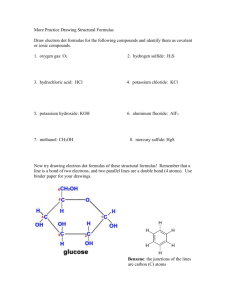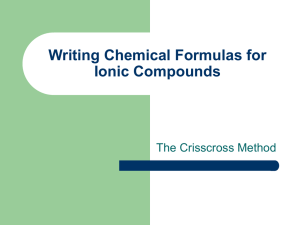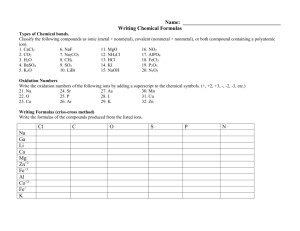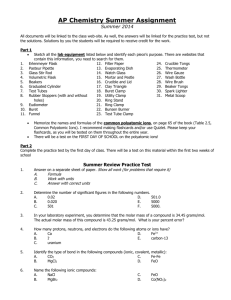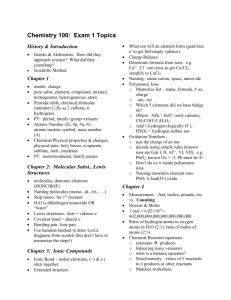AP Chemistry Summer Assignment
advertisement
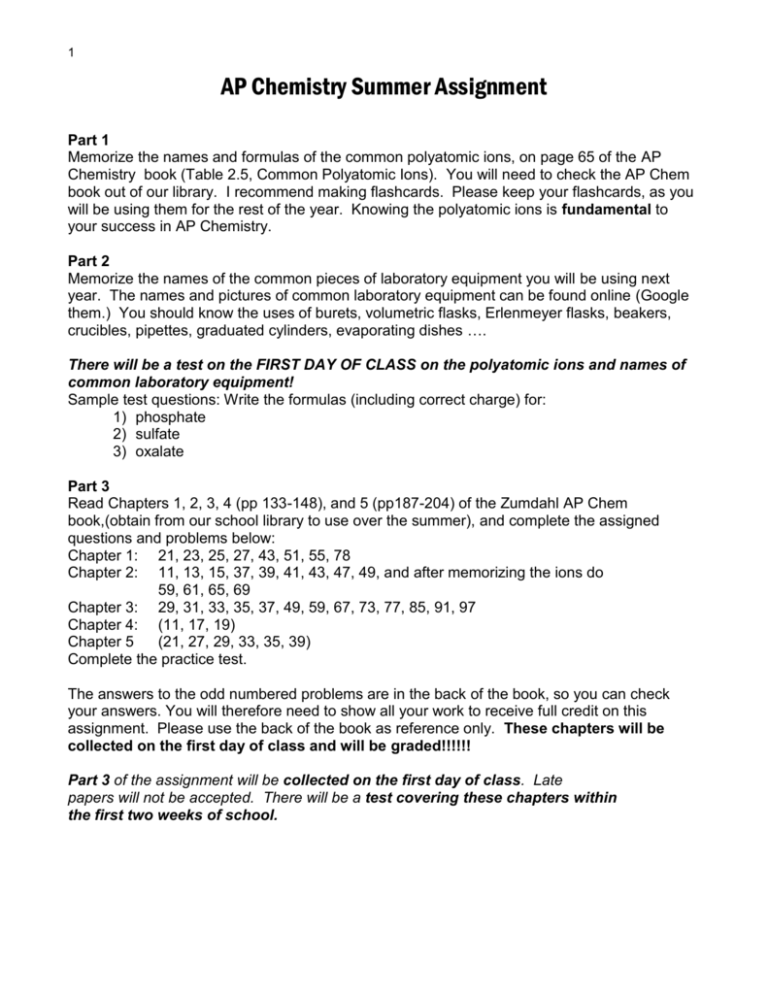
1 AP Chemistry Summer Assignment Part 1 Memorize the names and formulas of the common polyatomic ions, on page 65 of the AP Chemistry book (Table 2.5, Common Polyatomic Ions). You will need to check the AP Chem book out of our library. I recommend making flashcards. Please keep your flashcards, as you will be using them for the rest of the year. Knowing the polyatomic ions is fundamental to your success in AP Chemistry. Part 2 Memorize the names of the common pieces of laboratory equipment you will be using next year. The names and pictures of common laboratory equipment can be found online (Google them.) You should know the uses of burets, volumetric flasks, Erlenmeyer flasks, beakers, crucibles, pipettes, graduated cylinders, evaporating dishes …. There will be a test on the FIRST DAY OF CLASS on the polyatomic ions and names of common laboratory equipment! Sample test questions: Write the formulas (including correct charge) for: 1) phosphate 2) sulfate 3) oxalate Part 3 Read Chapters 1, 2, 3, 4 (pp 133-148), and 5 (pp187-204) of the Zumdahl AP Chem book,(obtain from our school library to use over the summer), and complete the assigned questions and problems below: Chapter 1: 21, 23, 25, 27, 43, 51, 55, 78 Chapter 2: 11, 13, 15, 37, 39, 41, 43, 47, 49, and after memorizing the ions do 59, 61, 65, 69 Chapter 3: 29, 31, 33, 35, 37, 49, 59, 67, 73, 77, 85, 91, 97 Chapter 4: (11, 17, 19) Chapter 5 (21, 27, 29, 33, 35, 39) Complete the practice test. The answers to the odd numbered problems are in the back of the book, so you can check your answers. You will therefore need to show all your work to receive full credit on this assignment. Please use the back of the book as reference only. These chapters will be collected on the first day of class and will be graded!!!!!! Part 3 of the assignment will be collected on the first day of class. Late papers will not be accepted. There will be a test covering these chapters within the first two weeks of school. 2 Help on Assignments These assignments are meant as a review of first year honors chemistry. If you have difficulty on these assignments, you may email me at csutliff@rjuhsd.us over the summer if you have any questions. I check my email on a daily basis prior to 7:00 PM. Have a great summer, and I look forward to seeing you next year! Mrs. Sutliff csutliff@rjuhsd.us Summer Review Practice Test Directions: Please answer all questions and show all work on separate paper 1) Determine the number of significant figures in the following numbers. a) 0.02 b) 0.020 c) 501 d) 501.0 e) 5000 g) 6,051.00 h) 0.0005 i) 0.1020 j) 10,001 k) 0.00310 f) 5000. l) 40.00 2) Determine the location of the last significant place value by underlining the digit. Example: 1.700 2 a) 8040 b) 0.0300 c) 699.5 d) 2.00 X 10 e) 0.90100 f) 90,100 -8 21 g) 4.7 X 10 h) 10,800. i) 3.01 X 10 j) 0.00410 k) 0.00210 l) 300,000 3) Perform the following calculations expressing the answer in the correct number of significant figures. 2 a) 1.35 m X 2.467 m b) 1035 m / 42 m c) 1.252 mm X 0.115 mm X 0.012 mm d) 505 kg – 450.25 kg e) (2.3 g X 1000 g) – 3.452 g f) 12.01 mL + 35.2 mL + 6 ml 4) In your laboratory experiment, you determine that the molar mass of a compound is 34.45 grams/mol. The actual molar mass of this compound is 43.25 grams/mol. What is your percent error? 5) Label the following as an atom, molecule, ion, or polyatomic ion: + 32a) Na b) Na c) PO4 d) CO2 e) S 3+ g) Fe h) SiO2 i) Co j) BH3 k) HC2H3O2 2- f) SO4 l) Ar 6) How many protons, neutrons, and electrons do the following atoms or ions have? + 2+ a) carbon b) lithium c) Li d) Ca e) Ca f) iodine 2+ 3+ g) I h) uranium i) barium j) Ba k) Fe l) carbon-13 7) Identify the type of bond in the following compounds (ionic, covalent, metallic): a) CO2 b) ) HC2H3O2 c) NaCl d) MgCl2 e) Fe-Fe f) FeO 8) Name the following ionic compounds: a) NaCl b) MgBr2 c) FeO d) K3PO4 e) Co(NO3)2 f)MgSO4 9) Name the following covalent compounds: a) CO2 b) C2H4 c) N2O3 c) B2H6 d) SCl6 e) P2O5 10) Write the formulas for the following ionic compounds (using the swap ‘n drop method): a) calcium chloride b) iron (III) oxide c) potassium nitrate d) titanium (IV) phosphate 11) Write the formulas for the following covalent compounds: a) diphosphorus pentoxide b) tricarbon octahydride c) carbon monoxide 3 12) How many atoms are in 1.2 mol of water? 13) How much does 6.42 mol of CH4 weigh? 14) How many atoms are in 0.0034 grams of NaCl? 15) Balance the following equations a) AlBr3 + K2SO4 KBr + Al2(SO4)3 b) HCl + CaCO3 CaCl2 + H2O + CO2 c) C4H8 + O2 CO2 + H2O 16) Balance the following equation, and answer the questions: Zn + HCl ZnCl2 + H2 a) How many moles of hydrogen gas can be produced from 2.34 moles of zinc metal? b) How many moles of zinc chloride can be produced from 2.34 grams of zinc metal? c) How many grams of hydrochloric acid do you need to react completely with 2.34 grams of zinc? 17) Balance the following reaction, and answer the questions: H2 + O2 H2O a) How many grams of water can you make from 33.44 g hydrogen, and 53.4 g of oxygen? b) How much excess reactant is left over? 18) What is the concentration/molarity of a solution in which 58 grams NaCl are dissolved in 2000. mL of solution? 19) How many grams of KNO3 should be used to prepare 100.0 mL of a 0.500 M solution? 20) Change the following temperatures from Celcius and Kelvin, and vice versa: a) 34.2°C K b) -34.5°C K c) 834 K °C d) 12 K °C 21) Covert the following units of pressure: a) 721 torr atm b) 1.53 atm mm Hg c) 0.034 kPa torr e) 0.92 atm kPa d) 342.34 mm Hg torr f) 923 mm Hg atm 22) A sample of oxygen gas occupies a volume of 250. mL at 740. torr pressure. What volume will it occupy at 800. torr pressure? 23) Chlorine gas occupies a volume of 25 mL at 34.5°C. What volume will it occupy at 600 K? 24) If a sample of gas occupies 3.0 L under 1.5 atm of pressure, at 20.0°C, what volume will it occupy at 2.5 atm and 30°C? 25) How many moles of oxygen will occupy a volume of 2.5 L at 1.2 atm and 25°C? 26) What volume will 454 grams of CO2 occupy at 345 torr and 34.4°C? 27) Find the number of grams of CO2 that exert a pressure of 785 torr at a volume of 323 mL and a temperature of 32°C. 28) Write the formulas for the following polyatomic ions. A correct formula must have the correct charge. a) nitrate b) carbonate c) phosphate d) sulfate e) sulfite f) nitrite g) chromate h) hypochlorite i) etc, etc, ect… know them all! STUDY THE NAMES AND FORMULAS OF THE POLYATOMIC IONS!!!! STUDY THE NAMES AND FORMULAS OF THE POLYATOMIC IONS!!!! STUDY THE NAMES AND FORMULAS OF THE POLYATOMIC IONS!!!! STUDY THE NAMES AND FORMULAS OF THE POLYATOMIC IONS!!!! STUDY THE NAMES AND FORMULAS OF THE POLYATOMIC IONS!!!! STUDY THE NAMES AND FORMULAS OF THE POLYATOMIC IONS!!!! 4 STUDY THE NAMES AND FORMULAS OF THE POLYATOMIC IONS!!!! STUDY THE NAMES AND FORMULAS OF THE POLYATOMIC IONS!!!! STUDY THE NAMES AND FORMULAS OF THE POLYATOMIC IONS!!!! STUDY THE NAMES AND FORMULAS OF THE POLYATOMIC IONS!!!! STUDY THE NAMES AND FORMULAS OF THE POLYATOMIC IONS!!!! STUDY THE NAMES AND FORMULAS OF THE POLYATOMIC IONS!!!! STUDY THE NAMES AND FORMULAS OF THE POLYATOMIC IONS!!!! STUDY THE NAMES AND FORMULAS OF THE POLYATOMIC IONS!!!! STUDY THE NAMES AND FORMULAS OF THE POLYATOMIC IONS!!!! STUDY THE NAMES AND FORMULAS OF THE POLYATOMIC IONS!!!! STUDY THE NAMES AND FORMULAS OF THE POLYATOMIC IONS!!!! STUDY THE NAMES AND FORMULAS OF THE POLYATOMIC IONS!!!! STUDY THE NAMES AND FORMULAS OF THE POLYATOMIC IONS!!!! STUDY THE NAMES AND FORMULAS OF THE POLYATOMIC IONS!!!! STUDY THE NAMES AND FORMULAS OF THE POLYATOMIC IONS!!!! STUDY THE NAMES AND FORMULAS OF THE POLYATOMIC IONS!!!! STUDY THE NAMES AND FORMULAS OF THE POLYATOMIC IONS!!!! STUDY THE NAMES AND FORMULAS OF THE POLYATOMIC IONS!!!! STUDY THE NAMES AND FORMULAS OF THE POLYATOMIC IONS!!!! STUDY THE NAMES AND FORMULAS OF THE POLYATOMIC IONS!!!! HAVE A NICE DAY!
